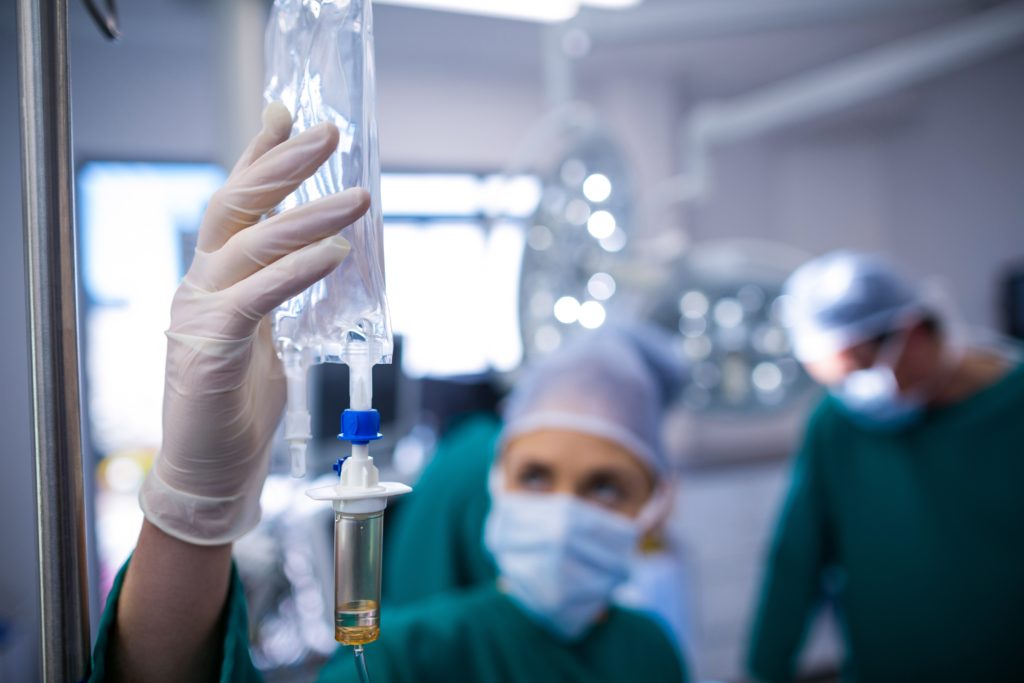General anesthesia, which is usually administered as a combination of intravenous (IV) drugs and inhaled gases, is used to put patients in a sleep-like, pain-free state before a surgery or medical procedure.1 Medical procedures that warrant general anesthesia include those that take a long time, result in significant blood loss, or take place in a cold environment and affect a patient’s breathing.1 The delivery of anesthesia drugs is highly complex and must be monitored by an anesthesiologist.2 Many studies compare the effects of various types of IV and inhaled general anesthesia drugs, such as Propofol, sevoflurane, desflurane, dexmedetomidine, remifentanil, midazolam and more.3-5 Because of the importance of these drugs in surgery, many researchers continue to follow the status of the general anesthesia drugs market.6-9
In 2018, the global general anesthesia drugs market was worth $4.17 billion.7 General anesthesia drugs can be segmented into IV drugs, accounting for 69.62 percent of the market, and inhalational anesthetics, accounting for 30.38 percent.8 Widely used IV drugs include Propofol, etomidate, midazolam, barbiturates and more, while the most common inhaled drugs are desflurane, isoflurane and sevoflurane.8 Propofol dominates the market at 33.83 percent of consumption, while sevoflurane accounts for 21.17 percent of the market.8 When segmented by region, the market is dominated by Europe as the largest producer and consumer of general anesthesia drugs.8 North America, particularly the United States, follows closely behind, with the two regions together accounting for over 55 percent of the production and consumption of general anesthesia drugs.6,8 The Asia Pacific region is also a key player in the market.8 Major manufacturers of general anesthesia drugs include Astrazeneca, Fresenius-Kabi, AbbVie, Baxter Healthcare, B. Braun, Maruishi, Piramal, Hikma Pharmaceuticals, Mylan, Nhwa, Hengrui and Lunan.8 Various drug types, regions and companies are involved in the dynamics of the general anesthesia drugs market.
Going forward, the global general anesthesia drugs market is expected to expand at a compound annual growth rate (CAGR) of approximately 3.7 percent over the next six years,6,9 though reports differ on the exact CAGR.7,8 A rising need for critical medical procedures—predominantly emergency, orthopedic and cosmetic surgeries—will increase demand for general anesthesia drugs.6 The Asia Pacific region in particular is expected to see rapid market growth, given expansion of medical facilities, government support of healthcare infrastructure and rising drug approvals.6,7 The value of the global general anesthesia drugs market is expected to rise to $4.3 billion by the end of 2019,7 and by some reports, much higher by 2025.8 Overall, researchers expect the market to see considerable growth over the next several years, particularly in the Asia Pacific region and for IV drugs.6
General anesthesia drugs play a vital role in anesthesiology, and their use in surgery is expected to contribute to market growth. As surgeries due to chronic illness increase worldwide and healthcare becomes more available, the market for general anesthesia drugs is expected to grow. Evolving policies across world regions and innovative technologies for IV drugs may also contribute to changes in the market.
1. Mayo Foundation for Medical Education and Research (MFMER). General Anesthesia. 2019; https://www.mayoclinic.org/tests-procedures/anesthesia/about/pac-20384568.
2. Bonhomme V, Staquet C, Montupil J, et al. General Anesthesia: A Probe to Explore Consciousness. Frontiers in Systems Neuroscience. 2019;13:36.
3. Rocha RG, Almeida EG, Carneiro LMM, Almeida NFd, Boas WWV, Gomez RS. Anesthesia recovery comparison between remifentanil-propofol and remifentanil-desflurane guided by Bispectral Index® monitoring. Revista Brasileira de Anestesiologia. 2017;67:500–507.
4. Ebert Thomas J, MD, PhD, Robinson Brian J, PhD, Uhrich Toni D, MS, Mackenthun A, PhD, Pichotta Philip J, BS. Recovery from Sevoflurane Anesthesia: A Comparison to Isoflurane and Propofol Anesthesia. Anesthesiology: The Journal of the American Society of Anesthesiologists. 1998;89(6):1524–1531.
5. North America Anesthesia Drugs Market to 2024 [press release]. Web: PR Newswire Association LLC June 24, 2019.
6. Ankush Nikam. General Anesthesia Drugs Market is Estimated to Grow at a CAGR of 3.8% by 2025. Web: Space Market Research; September 27, 2019.
7. Budholiya A. General Anaesthesia Drugs Market is expected to grow at a CAGR of ~3% during the forecast period of 2019 to 2029–Future Market Insights. Web: Future Market Insights; August 19, 2019.
8. General Anesthesia Drugs Market 2019: Global Industry Overview by Size, Share, Future Growth, Development, Revenue, Top Key Players Analysis and Growth Factors up to 2024 | 360 Market Updates [press release]. Web: MarketWatch, Inc. September 12, 2019.
9. Sawant A. Anesthesia Drugs Market to Increase worth to USD 4.9 Billion by 2022 Industry Forecast by Type, Applications, Drugs Deployment, Global Size on Growth Verticals 2019. Web: Market Research Future; July 1, 2019.
